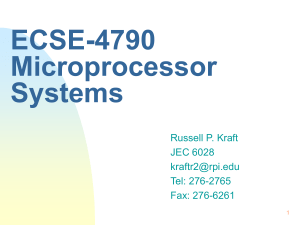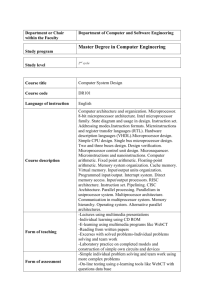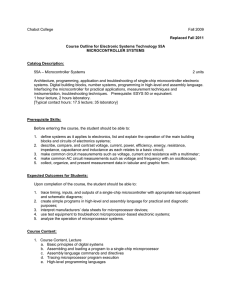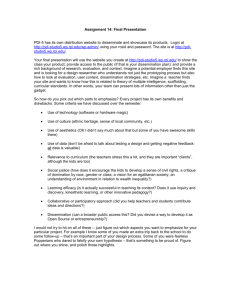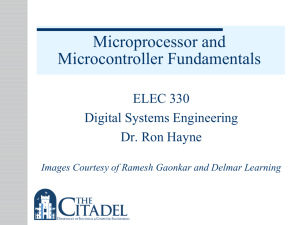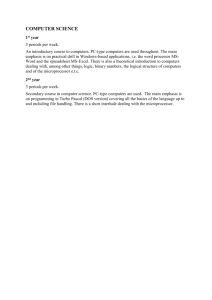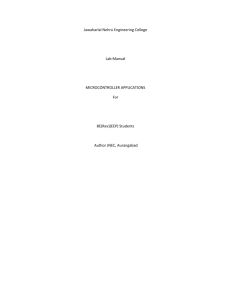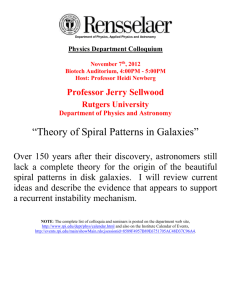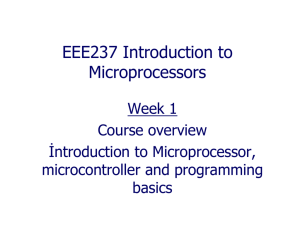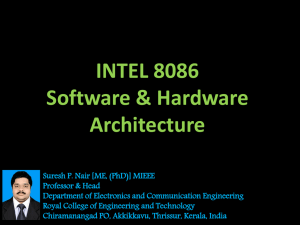ECSE-4790 Microprocessor Systems
advertisement
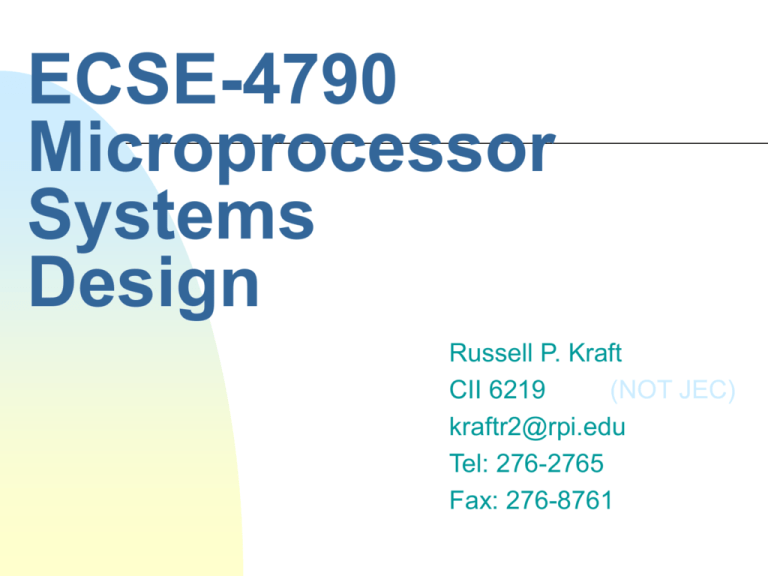
ECSE-4790 Microprocessor Systems Design Russell P. Kraft CII 6219 (NOT JEC) kraftr2@rpi.edu Tel: 276-2765 Fax: 276-8761 Teaching Assistants Srinivas Andra Omesh Tickoo Yong Xia andras@rpi.edu tickoo@rpi.edu xiay@rpi.edu 2 Catalog Description Hardware and software design of microprocessorbased digital systems. Basic concepts of microprocessor components and their fundamental machine instructions as related to their functional performance in digital systems. The logical characteristics of the devices are considered along with the architectures and software efficiencies of component families. Both 16 and 32 bit machines are treated. Weekly laboratory exercises in programming microprocessors and a team design project are required. 3 Course Goal Goal To provide fourth year ECSE students with a teambased capstone experience in microprocessor system design Means Exploratory laboratory exercises for the microcontroller. Team-based product design project 4 Course Prerequisites Prerequisites by topic Fundamentals of logic design Fundamentals of circuit design Computer programming Computer instruction sets Microcontroller operations 5 References Books Cady and Sibigtroth, Software and Hardware Engineering , Oxford University Press, New York, NY 2000. (REQUIRED) Gene H. Miller, Microcomputer Engineering, Second Edition, Prentice Hall, Englewood Cliffs, NJ 1998. (First Edition is fine.) Thomas L. Harman, The Motorola MC68332 Microcontroller, Prentice-Hall, Englewood Cliffs, NJ, 1991. (Easier to read than Motorola literature.) Alan Clements, Microprocessor Systems Design, PWS Publishing Company, Boston, MA, 1992. (Covers the 68000 family.) Online (www.ecse.rpi.edu/Courses/CStudio) 6 MPSD is a WebCT Course http://www.rpi.edu/web/webct Pick Fall 2002 Courses - Course Listing, ECSE and then Microprocessor Systems Design (ECSE 4790 00) Class handouts will be here (if you lose your copy) 7 Microcontrollers Available MC6811 — 8 bit machine introduced about 1985 MC6812 — 16 bit machine introduced late 1997 MC68332 — 32 bit machine introduced about 1990 8 Software Available Cross-assembler — Motorola C language cross-compiler — Introl Microprocessor simulator — Motorola 9 Typical Topics Introduction to the MC6812 microcontroller Introduction to the MC6811 & MC68332 microcontrollers Software development techniques Hardware development techniques Timers & Interrupt programming Interfacing memory to the microprocessor bus Synchronous & Asynchronous serial communication Analog conversion 10 Grade Computation Grades are assigned based on both team and individual effort Teams of 2 38% 6 MC6812 exercises Teams of 3 or 4 (5 in special cases) 62% • • • • • 5% 10% 12% 34% 25% • 4% • 10% Student selected course project Course project proposal 10/10 Interim demonstration Progress report 11/14 Final demonstration Final project report Due Tuesday, Dec. 9, 2002 at 4:00 PM Project notebook Post-project clean up, Peer reviews, & Teamwork 11 What This Means to You You get a chance to learn what you need to know to select and apply microcontrollers to applications of your own choosing Specific tools you will be using C cross-compilers Debuggers Simulators Logic Analyzers 12 Next Steps Reprise the MC6811 knowledge Do things in C that you formerly did using assembler Host input/output Interrupts Hardware interfacing etc. Follow up action items required of you Make a list of things you need to know about a new microcontroller to be able to use it as well as you can the MC6811 13 Class Requirements Professional Development III You must be registered for PD III (ENGR-4010) with MPSD to get credit needed for graduation. MPSD is 3 credits, PD III is 1 credit. Writing Center MPSD is a writing intensive course. You are expected to write well organized reports and will be graded on style. Use the Writing Center resources to improve your interim and project reports. 14 Lab Policies Lab experiment work (other than project) must be done in teams of only two students. Attendance will be taken and will count toward your performance grade. Unfair to partner when you don’t show up. Students with missing partners may team up for experiments. To get the highest grade on a lab exercise, something unique beyond the required tasks must be accomplished and demonstrated. Projects may have teams of 3 to 5 students, depending on the size of the project. 15 16 Special Projects - 2003 Part of a MDL (Multidisciplinary Design Lab) Project Automobile Enhancements & Others Using eye tracking & computer vision Various Sponsors Project to continue as Independent Senior Design Project through next semester More details will follow in later weeks 17
